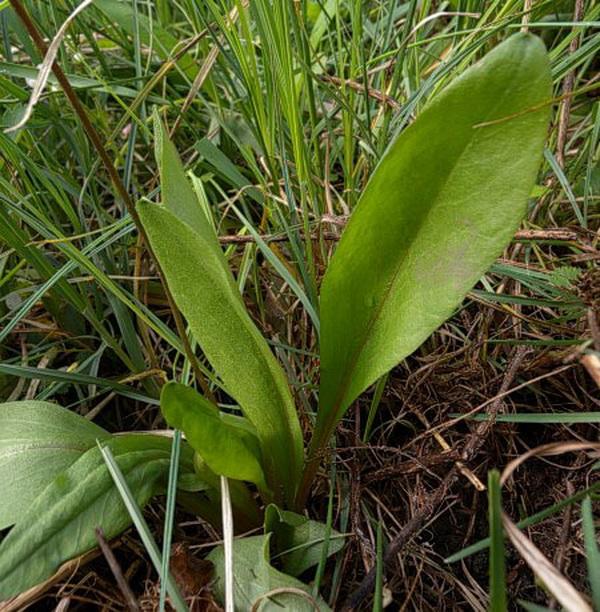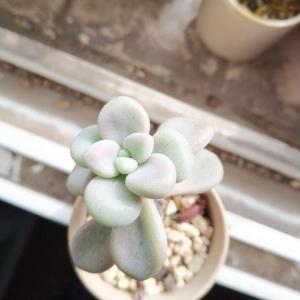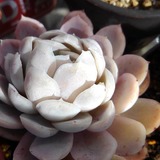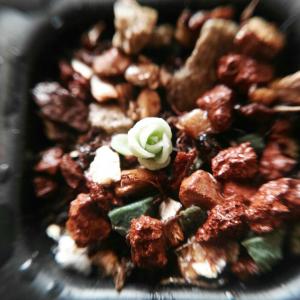文章
Miss Chen
2017年12月24日

Description: This perennial plant consists of a basal rosette of leaves, from which emerges one or more stalks of flowers. The leaves are up to 6" long and 2½" across, and oblong or oblanceolate. They are greyish green or green with a prominent central vein and smooth margins. There are finer side veins that are pinnately arranged. The foliage and other parts of this plant are hairless. A green or red flowering stalk emerges from the rosette that is about 1½' tall, from which an umbel of about 6-40 flowers dangle downward. Each flower has 5 petals that are reflexed upward, converging at the base of the flower, which consists of a pointed yellowish tube with white and brown accents. The petals are white, light pink, or rosy pink. There is no floral scent. In overall appearance, the inflorescence looks like a collection of pretty shooting stars, hence the common name for this plant. The blooming period occurs during late spring and lasts about a month. The entire plant dies down when summer arrives, although the dried up stalks persist somewhat longer. The small dark seeds are contained in seed capsules that are held erect (unlike the flowers). They are somewhat cylindrical, but taper at the ends. Gusts of wind shake the stalks holding the seed capsules, and can carry the seeds several feet away. The root system is fibrous. Over time, offsets can slowly form.
Cultivation: The preference is full or partial sun, and moist to slightly dry soil. Shooting Star can thrive on dry sunny slopes if there is sufficient rainfall during the spring because it dies down before summer droughts arrive. The soil can consist of loam with lots of organic material, or contain some rocky material. There is a preference for slopes, which reduces competition from taller plants. The foliage of mature plants dies down before disease can affect it. Shooting Star can be difficult to start from seed because of damping off, and it is slow to develop because of the short period of active growth. Transplants can also be temperamental, particularly if they are too small, or dug into the ground after the cool rainy weather of spring.
Range & Habitat: The native Shooting Star occurs in the majority of counties in Illinois (see Distribution Map). This plant is occasional to locally common in high quality habitats, otherwise it is rare or absent. Habitats include moist to slightly dry black soil prairies, hill prairies, openings in rocky upland forests, limestone glades, bluffs along major rivers, fens, and abandoned fields. An occasional wildfire during the late summer or fall is beneficial because it reduces the dead vegetation that can smother this plant during the spring.
Faunal Associations: Queen bumblebees are the most typical visitors of the oddly shaped flowers. They obtain pollen from the flowers by the rapid vibration of their thoracic muscles, which is sometimes called 'buzz pollination.' Other bees visiting the flowers are Anthophorine bees, Eucerine Miner bees, and Green Metallic bees. All of these insects collect pollen, as the flowers offer no nectar reward. The seeds are too small to be of much interest to birds. Mammalian herbivores may feed on the foliage during the spring, but little information is available about this.

Photographic Location: The photographs of the flowers and the basal leaf were taken at a wildflower garden near Red Bison Railroad Prairie in Champaign, Illinois.
Comments: This is one of the most beautiful spring wildflowers in the prairie. A colony of these plants in bloom is a sight not to be missed. The flowers of Shooting Star resemble in form those of Horse Nettle (Solanum carolinense) and other members of the Nightshade family. This is an example of convergent evolution between plants of different families because of similarities in the method of pollination. Early pioneers called this plant 'Prairie Pointers.'
Cultivation: The preference is full or partial sun, and moist to slightly dry soil. Shooting Star can thrive on dry sunny slopes if there is sufficient rainfall during the spring because it dies down before summer droughts arrive. The soil can consist of loam with lots of organic material, or contain some rocky material. There is a preference for slopes, which reduces competition from taller plants. The foliage of mature plants dies down before disease can affect it. Shooting Star can be difficult to start from seed because of damping off, and it is slow to develop because of the short period of active growth. Transplants can also be temperamental, particularly if they are too small, or dug into the ground after the cool rainy weather of spring.
Range & Habitat: The native Shooting Star occurs in the majority of counties in Illinois (see Distribution Map). This plant is occasional to locally common in high quality habitats, otherwise it is rare or absent. Habitats include moist to slightly dry black soil prairies, hill prairies, openings in rocky upland forests, limestone glades, bluffs along major rivers, fens, and abandoned fields. An occasional wildfire during the late summer or fall is beneficial because it reduces the dead vegetation that can smother this plant during the spring.
Faunal Associations: Queen bumblebees are the most typical visitors of the oddly shaped flowers. They obtain pollen from the flowers by the rapid vibration of their thoracic muscles, which is sometimes called 'buzz pollination.' Other bees visiting the flowers are Anthophorine bees, Eucerine Miner bees, and Green Metallic bees. All of these insects collect pollen, as the flowers offer no nectar reward. The seeds are too small to be of much interest to birds. Mammalian herbivores may feed on the foliage during the spring, but little information is available about this.

Photographic Location: The photographs of the flowers and the basal leaf were taken at a wildflower garden near Red Bison Railroad Prairie in Champaign, Illinois.
Comments: This is one of the most beautiful spring wildflowers in the prairie. A colony of these plants in bloom is a sight not to be missed. The flowers of Shooting Star resemble in form those of Horse Nettle (Solanum carolinense) and other members of the Nightshade family. This is an example of convergent evolution between plants of different families because of similarities in the method of pollination. Early pioneers called this plant 'Prairie Pointers.'
0
1
文章
Miss Chen
2017年12月24日

Description: This perennial wildflower consists of a low rosette of basal leaves and a flowering stalk of flowers about ½–1½' tall. The basal leaves are up to 6" long and 2½" across; they are ovate-oblong or obovate, medium green, hairless, and smooth along their margins. The erect flowering stalk is hairless and devoid of leaves; at its apex there is an umbel of 3-20 flowers. The flowers nod downward from their drooping pedicels. Each flower is about ¾" long, consisting of a corolla with 5 oblong lobes, a light green calyx with 5 triangular teeth, and 5 stamens that are appressed together around a single slender style. The corolla is usually rosy pink, although sometimes it is a lighter shade of pink. The lobes of the corolla are turned inside-out, fully exposing the reproductive organs (which are pointed downward). Near its base, the corolla has patches of yellow and white. The anthers of the stamens are yellowish orange. The blooming period occurs during the late spring for about 2 weeks. Afterwards, the pedicels of the flowers turn upward and the developing seed capsules are held erect. At maturity, the papery walls of the seed capsules become light brown. Each seed capsule contains many tiny seeds. The root system consists of a crown of fibrous roots. The foliage withers away by mid-summer. This wildflower reproduces by reseeding itself.
Cultivation: The preference is full or partial sun during the period of vegetative growth and development. This occurs during the spring and it is quite rapid. At this time, ample moisture and cool to moderate temperatures are required. This wildflower can adapt to a loamy garden soil, but it often occurs on rocky slopes in its native habitat. Some protection from the hot afternoon sun is desirable, but not required if there is ample moisture.
Range & Habitat: Amethyst Shooting Star is found in only a few counties in NW and west-central Illinois (see Distribution Map); it is native and uncommon. Habitats include thinly wooded bluffs, rocky cliffs, and sheltered areas of upland prairies where moisture tends to accumulate. In Illinois, this wildflower is found in hilly areas along the Illinois and Mississippi Rivers. In other states, it is often found in mountainous areas.
Faunal Associations: The flowers are visited by bumblebees and other bees for their pollen. Through the rapid vibration of their abdominal muscles, bumblebee visitors engage in "buzz pollination," which induces the flower to release its pollen. The low foliage is probably edible to mammalian herbivores, but it is rarely eaten because of its inconspicuous and ephemeral nature.

Photographic Location: The wildflower garden of the webmaster in Urbana, Illinois.
Comments: This is a little jewel of a plant. It closely resembles the more common Dodecatheon meadia (Shooting Star), but the flowers of Amethyst Shooting Star are usually a deeper shade of pink. In general, Amethyst Shooting Star is slightly smaller in size than Shooting Star, and the flowering stalk of each plant has a tendency to produce fewer flowers (less than 20); sometimes, the flowering stalk of a robust Shooting Star produces substantially more than 20 flowers. The most critical difference between these two plants, however, consists of the characteristics of their seed capsules: At maturity, the seed capsules of Amethyst Shooting Star are light brown and thin-walled, while the seed capsules of Shooting Star are dark brown and thick-walled. The basal leaves of these two species are very similar.
Cultivation: The preference is full or partial sun during the period of vegetative growth and development. This occurs during the spring and it is quite rapid. At this time, ample moisture and cool to moderate temperatures are required. This wildflower can adapt to a loamy garden soil, but it often occurs on rocky slopes in its native habitat. Some protection from the hot afternoon sun is desirable, but not required if there is ample moisture.
Range & Habitat: Amethyst Shooting Star is found in only a few counties in NW and west-central Illinois (see Distribution Map); it is native and uncommon. Habitats include thinly wooded bluffs, rocky cliffs, and sheltered areas of upland prairies where moisture tends to accumulate. In Illinois, this wildflower is found in hilly areas along the Illinois and Mississippi Rivers. In other states, it is often found in mountainous areas.
Faunal Associations: The flowers are visited by bumblebees and other bees for their pollen. Through the rapid vibration of their abdominal muscles, bumblebee visitors engage in "buzz pollination," which induces the flower to release its pollen. The low foliage is probably edible to mammalian herbivores, but it is rarely eaten because of its inconspicuous and ephemeral nature.

Photographic Location: The wildflower garden of the webmaster in Urbana, Illinois.
Comments: This is a little jewel of a plant. It closely resembles the more common Dodecatheon meadia (Shooting Star), but the flowers of Amethyst Shooting Star are usually a deeper shade of pink. In general, Amethyst Shooting Star is slightly smaller in size than Shooting Star, and the flowering stalk of each plant has a tendency to produce fewer flowers (less than 20); sometimes, the flowering stalk of a robust Shooting Star produces substantially more than 20 flowers. The most critical difference between these two plants, however, consists of the characteristics of their seed capsules: At maturity, the seed capsules of Amethyst Shooting Star are light brown and thin-walled, while the seed capsules of Shooting Star are dark brown and thick-walled. The basal leaves of these two species are very similar.
0
1




















